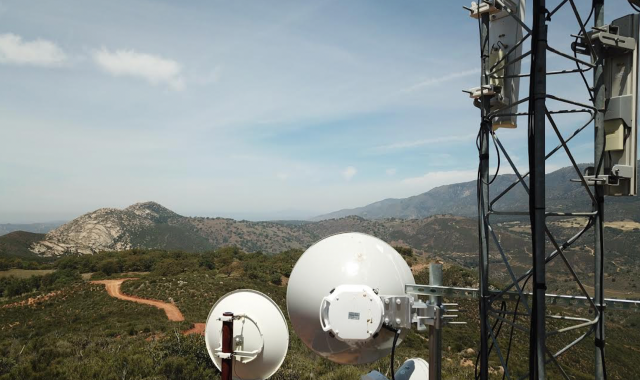
LA MIRADA, CA — Jan. 15, 2020 — Fourteen Native American tribes in Southern California are now directly connected to the state-of-the-art International Internet Exchange, Pacific Wave, and its peering, high-performance scientific networks, and ever-expanding global connectivity. Six more tribes are also expected to join in the coming months. This new connection enables tribal libraries, scientific research facilities, and cultural preservation institutions to collaborate with partners across the state, the nation, and the world.
Tribal Digital Village, a tribal consortium-owned Internet service provider in San Diego County, has connected to Pacific Wave’s infrastructure on the West Coast. A joint project of CENIC and the Pacific Northwest Gigapop(PNWGP), Pacific Wave interconnects most international Asia-Pacific research and education networks, key US Western regional research and education networks, leading national-scale research networks, and major commercial research cloud services.
Tribal Digital Village Network (TDVnet) was created by the Southern California Tribal Chairman’s Association (SCTCA) in 2001 to bring Internet services to key community buildings and resource programs on reservations. The 14 tribes now connected to Pacific Wave through TDVnet are:
- Barona Band of Mission Indians
- Cahuilla Band of Mission Indians
- Campo Band of Kumeyaay Indians
- Ewiiaapaayp Band of Kumeyaay Indians
- Iipay Nation of Santa Ysabel
- La Jolla Band of Luiseño Indians
- La Posta Band of Mission Indians
- Los Coyotes Band of Cahuilla and Cupeño Indians
- Manzanita Band of the Kumeyaay Indians
- Mesa Grande Band of Mission Indians
- Pala Band of Mission Indians
- Pauma Band of Luiseño Indians
- Rincon Band of Luiseño Indians
- San Pasqual Band of Mission Indians
“Through this new connection to Pacific Wave, thousands of indigenous people will benefit from enhanced connectivity,” said Director of Technology for the SCTCA and Director of TDVnet Matt Rantanen. “All of these tribes have facilities that are now connected to regional, national, and international partners in the research and education community and beyond. This collaboration is an important start to bring global indigenous people onto a platform where they can connect throughout the Asia-Pacific Region and share their efforts to strengthen their communities. We all have very similar stories and histories of hardship and oppression, and could greatly benefit from sharing our individual solutions to overcome these obstacles and strengthen our communities as a whole.”
Pacific Wave’s 100-Gbps backbone has access points in Seattle; Sunnyvale, CA; Los Angeles; and Tokyo. In addition, there are interconnection points of presence in Chicago, Portland, Denver, Dallas, Houston, Kansas City, and Tulsa. Operated in collaboration with the University of Southern California and the University of Washington, Pacific Wave is the official USA National Science Foundation-funded interconnection and international peering facility, and Software-Defined Exchange (SDX) for Pacific Rim networks.
“Like the countries that Pacific Wave International Exchange connects, Native American tribes are sovereign nations and therefore should have access to the international exchange and its accompanying domestic peering,” said Pacific Wave Board Director and President and CEO of CENIC, Louis Fox. “California and the entire research and education community are beneficiaries of this partnership as it will bring tribal libraries, scientific research facilities, and cultural preservation institutions onto the same networks as their peers, not just in the West, but across the US, and around the globe; and it facilitates many other partnerships among schools, cultural institutions, governments, and health care organizations.”
PNWGP and CENIC established the connection with TDVnet with help from Google and AT&T. Google’s Project Eagle Feather provided TDVnet with resources to enhance intra-tribal connectivity. AT&T provided a 10-Gbps circuit through their partnership with CENIC, which can be increased to multiple 10-Gbps or 100-Gbps circuits as demand increases, from TDVnet to a CENIC point of presence in San Diego. CENIC provided backhaul to Pacific Wave infrastructure in Los Angeles and Sunnyvale. Traffic began passing on the new connection in November.
“By working together and sharing resources, PNWGP, CENIC, SCTCA, Google, and AT&T have made it possible for all of us to do more, and in reality do it better with less than if we pursued these infrastructure deployments alone,” said Pacific Wave Board Director and CEO of PNWGP, Ron Johnson.
“Native Americans in Tribal Areas are among the least connected people in America,” said Google Vice President and Chief Internet Evangelist Vint Cerf. “This new interconnection and the incontrovertible logic behind it, is a dramatic way to draw tribal communities into a rapidly digitizing world.”
“We are proud to be a part of this important partnership to provide these tribes with the Internet access they need to bolster education, employment, and health care, and to significantly improve the overall quality of life,” said Chris Congo, AT&T AVP Global Business.
To date, TDVnet has resulted in more than 650 miles of point-to-point and point-to-multipoint links supporting 105 tribal buildings including tribal administration buildings, Environmental Protection Agency departments, fire stations, law enforcement facilities, utility departments, and libraries, schools, and Head Start programs.
“We believe this partnership between Pacific Wave, private sector partners, and tribal communities has the potential to be replicated and extended initially in California, Washington, and Montana and, eventually, throughout the West. I look forward to engaging my research and education and private sector colleagues in related efforts,” said Fox.
Tribal Digital Village Network (TDVNet) is supported by Google through the People-Centered Internet’s “Project Eagle Feather.”
People-Centered Internet (PCI) is a 501(c)3 nonprofit organization working to ensure that the Internet is a positive force for good, improving the lives and well-being of people around the world. This includes promoting connectivity, fighting disinformation, contributing to the discussion about technology ethics, supporting the development of people-centered applications and initiatives, advising policymakers, and leveraging technology to help communities be more resilient.

1 comment